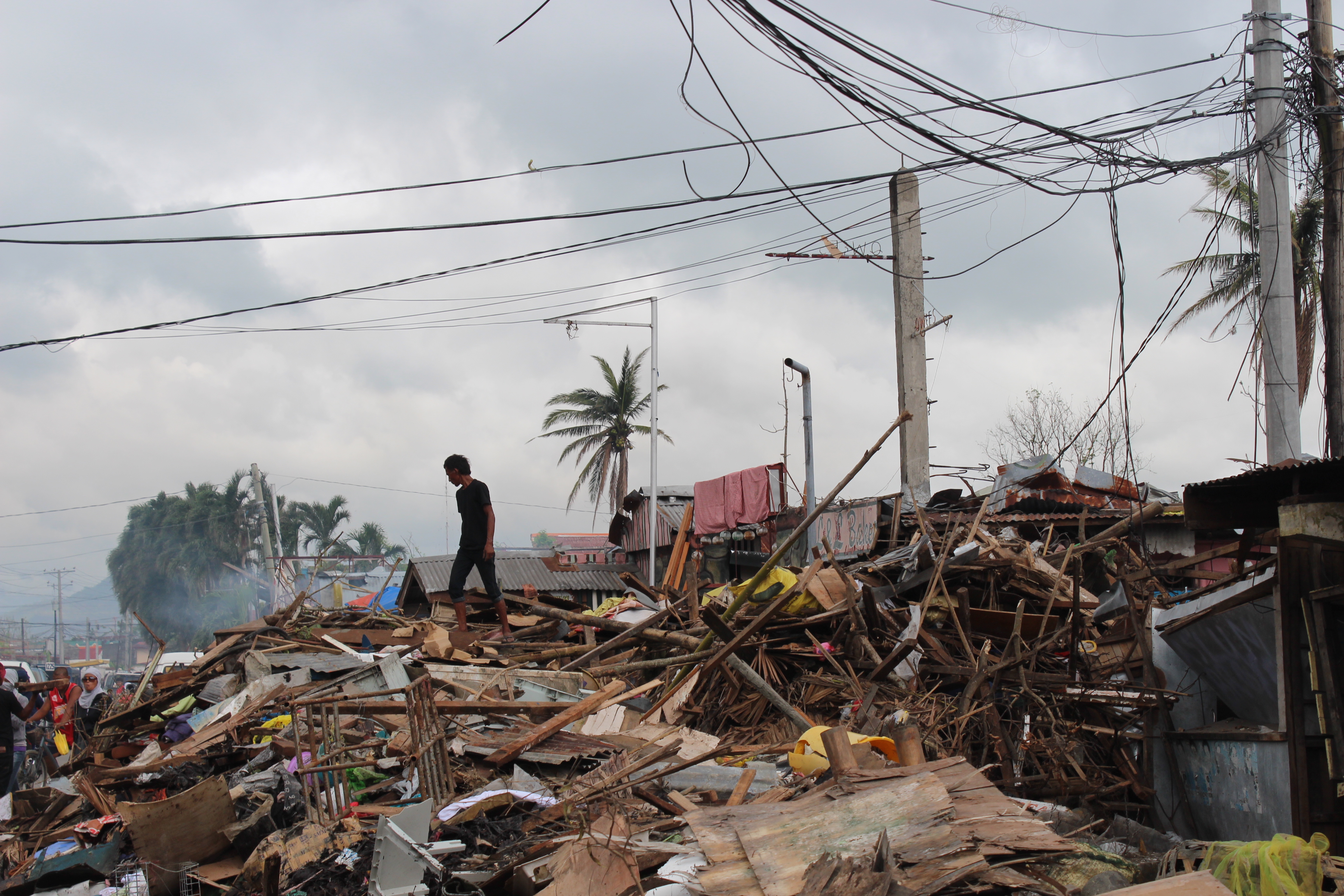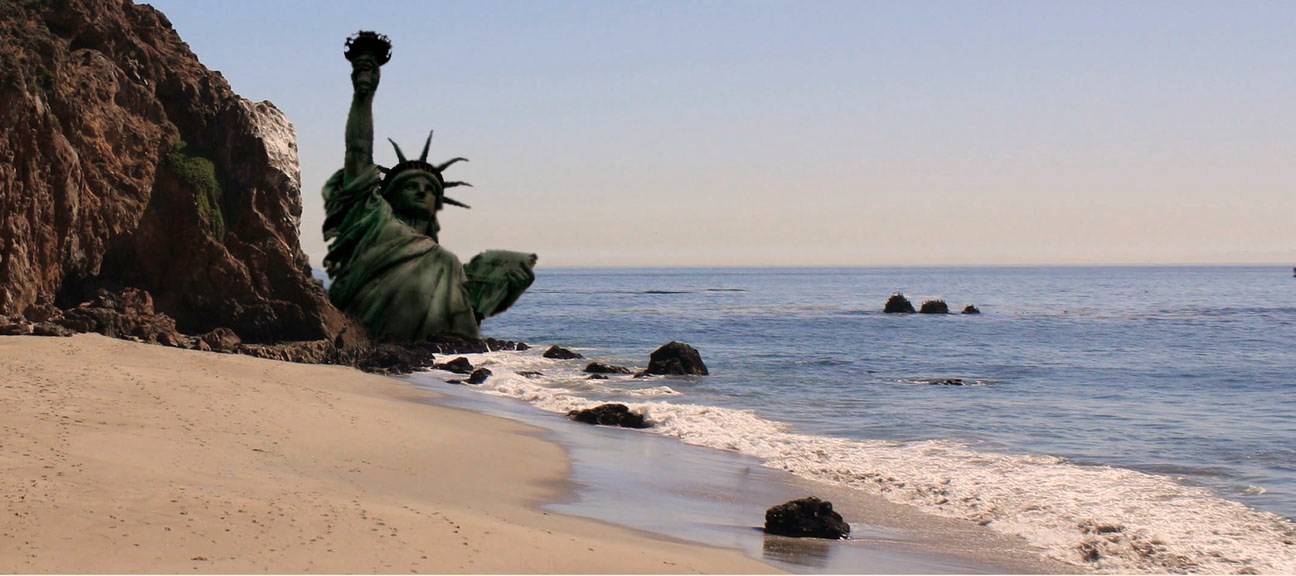Sebastian Groes
Proleptic Mourning: an introduction to the art of climate change
The topics of the first two ‘Memory Network @ Cheltenham Events’ proved a tad depressing. The first event explored the ineradicable digital traces we leave behind after we die, and the second discussed our increasingly chaotic, uncontrollable world in which memory is less and less useful in predicting our way out of our twenty-first century mess. The third proved no more cheerful. ‘Climate Change and the Art of Memory’ started from the assumption that climate change threatens humankind with extinction. Unforeseen and large-scale ecological phenomena and changes have been, and are, manifesting themselves with increasing ferocity. Although some of us will (for now) feel the impact more than others – one might think for instance of those populations who live in Hurricane Valley in the United States or the Philippines – climate change is likely to affect us all.
Connecting climate change to memory is perhaps a counter-intuitive starting point: climate change is all about future catastrophe. But questions about memory proliferate as soon as you start to think about climate change:
What does it mean to live with a shrinking future and an expanding memory?
Why doesn’t the knowledge we are choking the earth not make us remember to behave more sensibly?
Why don’t our imagined memories of stable weather in our youth propel us to reclaim that sense of stability?
Memory Network-member Professor Claire Colebrook (PennState, USA) also pointed to the idea of the Anthropocene (invented by Nobel Prize winner Paul Crutzen, in 2002), which suggest there will be a time when mankind has ceased to exist and there will be a distinct geological strata of detritus that mankind has left behind. Works of art have been speculating about the end of the world. Recent examples in film include Lars von Trier in Melancholia (2011) and other Hollywood (post-)apocalyptic disaster films (including Will Smith’s I Am Legend [Francis Lawrence, 2007] and more recently Matt Damon’s Elysium [Neill Blomkamp, 2013]) The theme is also the subject of novels such as Will Self’s The Book of Dave (2006), Margaret Atwood’s Oryx and Crake (2003) and The Year of the Flood (2009), Cormac McCarthy’s The Road (2006), Maggie Gee’s The Flood (2004) and The Ice People (1999), and Kim Stanley Robinson’s triptych Forty Signs of Rain (2004), Fifty Degrees Below (2005) and Sixty Days and Counting (2007). All these apocalyptic works generate a form of ‘proleptic mourning’, whereby we already lament our fate and grieve for ourselves as if we were dead already. We project ourselves into an imagined vantage point in the future and look back on the world of humans and the moment of our demise. We become an imagined future memory.
The complexity of this idea is drawn from a rethinking of time and memory over the past two centuries. Before Darwin, memory was driven by two intertwined versions: one was individual, embodied time, which was itself encapsulated by a second, wider framework provided by Biblical time-scales. Both were deeply anthropocentric. At the end of the eighteenth century, mathematical experiments and climatological simulation began to slowly displace this human time, and Darwin’s revolution completed a non- anthropocentric thinking in which climatological time reduced the centrality of humans. Not only time, but memory as well has, as a consequence, been rethought: much more central now are climatological and geological memory, and perhaps cosmic memory, which dwarfs individual, embodied memory part of individualistic anthropocentric thinking. One of the problems for us humans is that we lack the imagination to actually comprehend such vast temporal scales. Will there ever be a climate change novel or film which, through setting alight our imagination and memory, is a pivotal, decisive influence on global public opinion? The question is fraught with a multiplicity of complex problems.
‘Weather Weirding’: winter should be winters, summers should be summers
The Memory Network invited one of the key climate change scientists, Mike Hulme, Professor of Climate Change and Culture at King’s College London, formerly of the Tyndall Centre at the University of East Anglia to their Cheltenham Festival event. Hulme started off by quoting from one of the first climate change reports, from the 1930s, which contained a lot of subjective, anecdotal evidence by elderly people, who always claim that ‘When I was younger ‘the summers were sunnier’ and ‘the winters were colder’, et cetera’. Hulme noted that interpreting the truthfulness of such claims is not always easy; human memories of past weather are often selective and malleable. But, the point is that those sentiments demonstrate the intimate relationship between climate, weather and humans: ‘We absorb the experience of the atmosphere into our own lives and memories. It’s as though the weather provides these structures, these bookends, around which then we navigate, safely, for the rest of our lives. In our imagination, this is how weather should perform. Winter should be winters, summers should be summers. They provide an envelope of stability, of normalcy. Weather acts as a subliminal comfort.’ This is why the idea climate change is so disturbing to us: it unsettles the subliminal structure of comfort. In the popular discourse this is called ‘Weather Weirding’, in which seasons are knocked out of their ‘proper’ sequence; the weather is much more unpredictable than it used to be. Thus climate change is destabilizing the anchors that have come to us via our personal memories. ‘We feel that we cannot make sense of our lives if the weather is all weird.’ Hulme finished his musings with a provocative question: ‘If humans are indeed operating on a scale on this planet that is changing the climate, then are we not able to embrace the novelty that is ensuing and will ensue?’ Rather than fearing the instability that our changing ecology presents, isn’t it also a source of new possibility and imaginative opportunity?
This was the cue for one of the writers thinking about climate change in her fiction to present her thoughts: Maggie Gee. Her The Ice People centres not on global warming but instead imagines a freeze. The novel projects current social constellations and problems into future, showing how the current global power bias in which the white north-west ruled over the poor dark-skinned southeast might actually be reversed by climate change. As the north has become too cold to survive, whites are seeking refuge in the gentle, moderate climate of Africa. The power of Gee’s novel comes not from making ironic pronouncements about geopolitical injustices, however, but it demonstrates the climatological impact on the life of one single man, Saul. It reminds us of what makes human life human: emotions, love, desire, friendship and a duty of care towards fellow (wo)man.
Gee stressed that thinking and writing about climate change starts from a personal experience. Writing about the natural world came about very subtly, by growing up in the country side in Dorset, Worcestershire, and Sussex with parents who were fanatical walkers, had no car, and took the young Maggie camping: ‘I remember the glacier at Gletsch, in the Vallée Canton in Switzerland, where we went camping. I was eleven years old when we walked up to Gletsch – a monumental presence – and we clambered onto the boulders at the edge and looked into some of the cracks in the ice: you had dust of a brilliant turquoise colour. It is something I can never, never forget. Now, Gletsch has retreated and is less of that unforgettable presence it was to us.’
Gee noted that, for her, art is memory, a record of human consciousness. ‘My view is that all living things on the planet have their own form of consciousness. But, as far as we know, we’re the only species who record that consciousness. Artists keep a record. From Anglo Saxon riddles and Chaucer to William Blake and Ted Hughes, there is a shining record of how nature in these islands has filled people’s lives with joy and wonder and horror. Shakespeare’s imagery is so vital and so various because he lived among a great wealth of plants and animals and birds.’ Does she feel, then, that artists have a duty to defend the earth and its wonderful array of research and species? For Gee, writing about climate change is not an obligation for writers per se: ‘As soon as you say ‘write about climate change’ it turns into an ought, and novelists and poets don’t want to write about oughts. They want to write about things that move them, and things that are integral to their lives. And that’s why I’ve told you my life story: that’s where this love of, and this desire to observe to, nature comes from.’
The Future Perfect Subjunctive: the Eremozoic Age and Time of Climate Change
Ecocritic and English Literature Lecturer Greg Garrard continued to speak passionately about a problem in the current debate about climate change: ‘Climate change has suffered from ‘scientification’: a vast series of complex problems has been reduced to just the scientific questions, and our consciousness has been organized around the IPCC [Intergovernmental Panel on Climate Change] process, and whether this will lead to a multilaterally negotiated climate agreement. We’ve lost track of the idea that climate change is caused by more than just greenhouse gasses and that its effect will be felt in more than just the global mean temperature, the index of climate sensitivity.’ Our task, according to Garrard, was to talk about how we can broaden climate change from this narrow scientific basis, as well as move away from ‘humancentredness’, which assumes only the fate of human being matters.
Garrard picked up on the idea of ‘proleptic mourning’ and used the film The Age of Stupid (Fanny Armstrong, 2009), to speak about the numerous intellectual contradictions climate change puts to us. The Age of Stupid is set fifty years into the future and looks back on our contemporary world. Garrard: ‘If climate change had a grammatical tense, it would be the future perfect subjective. We’re being asked to look forward in order to look back upon ourselves today with a sense of shame andembarrassment that we didn’t act sooner and more dramatically. This is a mode we see a lot in apocalyptic fictions.’ Garrard went into detail by looking at the ambiguous representation of the child in these fictional responses: ‘When we talk in political terms, children represent the future. Children stand for the future; we want to save the planet for our children. But when it comes to climate change, children have an uncomfortable aspect. Human population growth is one of the biggest contributors to growth in greenhouse gasses, so, on the one hand, we invest our political hopes in children, but it actually might be better to not have any children at all.’ This traditional metaphor has therefore become obsolete, dangerous and should be reconsidered.
Garrard also unpicked the idea of the Anthropocene, and moved on to an idea of biologist E. O. Wilson, who talks about the history of the planet not in geological, but in zoological ages. According to Wilson, the Eremozoic Age will begin at the end of the twenty-first century when extinction rates approach those of earlier spasms and catastrophes. Wilson draws attention to the fact that humans are causing a loss of biodiversity. This sharpen the human condition: ‘There’s a poetic justice about mankind’s arrogance. The future will be lonelier. The Eremozoic is the age of loneliness. And we realize a new irony: although the Anthropone and the Eremozoic place humans at the centre of the world, we cannot be under any illusion that we’re in control of the processes that we’re causing. As the philosopher John Gray has suggested, our technological progress and our moral progress never really keep pace because technological progress is cumulative whereas every generation needs to learn morality all over again – we don’t inherit morality.’
Garrard again meditated on the temporal complexities of climate change in relationship to the limitedness of the human imagination. ‘A gas like methane is recycled by the atmosphere in a decade. CO2 lasts about 150 years. But CFCs could last in the atmosphere for three or four thousand years. One the one hand, we have this incredibly compressed time-scale of our ordinary daily lives and, on the other one, we have this incredibly distended one, which none of us are equipped to imagine.’ Climate change is asking too much of our imagination, unless we have the right kind of artistry to create works that somehow manage bridge this divide and also have a major impact on the popular imagination.
Riffing on Milan Kundera’s postmodern masterpiece The Unbearable Lightness of Being (1984), Garrard ended with a paradox he calls ‘The Unbearable Lightness of Being Green’: ‘The more human beings there are, the more cumulatively our effect as a species becomes. When you think of the numbers – 7 billion, 9 billion, 12 billion – the mass of it! There’s this terrifying weight of human numbers, and the apocalypse feels unavoidable. But then there’s another side to it: the more of us there are, the less I, as an individual, matter. Milan Kundera thinks about this in relationship to Beethoven, who felt the weight of human existence; it became his burden. Kundera says that our problem today is not weight but lightness, and insubstantiality. We’re not sure we matter. Climate change is unbearably light: we know that as a species our impact is enormous, but precisely because it’s based on the exponential increase in our numbers, it also dilutes our agency to the point where it’s supposed to matter whether I switch the lights on or off. That is the most dislocating effect of climates change; it’s the contradiction of scales.’








